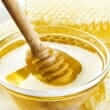Background
- Honey is a sweet, viscid fluid produced by honeybees (Apis melliflera) from the nectar of flowers. It is generally recognized as safe (GRAS), but there have been numerous reports of certain types of honey produced from the nectar of flowering plants from the genus Rhododendron and others that have toxic effects in humans and in animals.
- Honey is easily absorbed and utilized by the body. It contains about 70-80% sugar; the rest is water, minerals, and traces of protein, acids, and other substances. Honey has been used by ancient Egyptians, Assyrians, Chinese, Romans, and Greeks as a medicinal remedy for the management of wounds, skin ailments, and various gastrointestinal diseases.
- Honey's therapeutic importance as a known antibacterial agent has been recognized since 1892. Modern research has been conducted on the role of honey in chronic wound management and other indications. However, high quality studies are lacking, and further research is warranted to establish the therapeutic effect of honey in any indication.
References
- Abenavoli FM, Corelli R. Honey therapy. Ann.Plast.Surg. 2004;52(6):627.
View Abstract - Al Waili NS. Topical honey application vs. acyclovir for the treatment of recurrent herpes simplex lesions. Med.Sci.Monit. 2004;10(8):MT94-MT98.
View Abstract - Bose B. Honey or sugar in treatment of infected wounds? Lancet 4-24-1982;1(8278):963.
View Abstract - Hou YC, Ching H, Chao PD, et al. Effects of glucose, fructose and 5-hydroxymethyl-2-furaldehyde on the presystemic metabolism and absorption of glycyrrhizin in rabbits. J.Pharm.Pharmacol. 2005;57(2):247-251.
View Abstract - Kaufmann A, Kaenzig A. Contamination of honey by the herbicide asulam and its antibacterial active metabolite sulfanilamide. Food Addit.Contam 2004;21(6):564-571.
View Abstract - Keast-Butler J. Honey for necrotic malignant breast ulcers. Lancet 10-11-1980;2(8198):809.
View Abstract - Molan PC, Betts JA. Clinical usage of honey as a wound dressing: an update. J.Wound.Care 2004;13(9):353-356.
View Abstract - Postmes T, van den Bogaard AE, Hazen M. Honey for wounds, ulcers, and skin graft preservation. Lancet 3-20-1993;341(8847):756-757.
View Abstract - Schumacher HH. Use of medical honey in patients with chronic venous leg ulcers after split-skin grafting. J.Wound.Care 2004;13(10):451-452.
View Abstract - Staunton CJ, Halliday LC, Garcia KD. The use of honey as a topical dressing to treat a large, devitalized wound in a stumptail macaque (Macaca arctoides). Contemp.Top Lab Anim Sci. 2005;44(4):43-45.
View Abstract - Subrahmanyam M. A prospective randomised clinical and histological study of superficial burn wound healing with honey and silver sulfadiazine. Burns 1998;24(2):157-161.
View Abstract - Subrahmanyam M. Early tangential excision and skin grafting of moderate burns is superior to honey dressing: a prospective randomised trial. Burns 1999;25(8):729-731.
View Abstract - Subrahmanyam M. Honey dressing versus boiled potato peel in the treatment of burns: a prospective randomized study. Burns 1996;22(6):491-493.
View Abstract - Subrahmanyam M. Honey impregnated gauze versus polyurethane film (OpSite) in the treatment of burns--a prospective randomised study. Br.J.Plast.Surg. 1993;46(4):322-323.
View Abstract - Subrahmanyam M. Storage of skin grafts in honey. Lancet 1-2-1993;341(8836):63-64.
View Abstract







